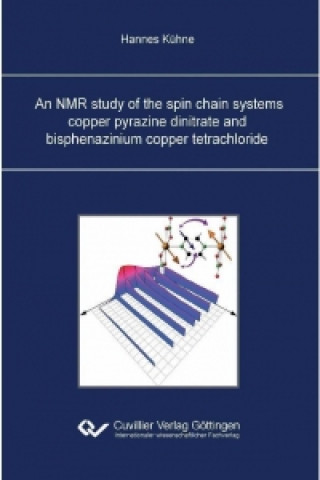
Kod: 12738845
An NMR study of the spin chain systems copper pyrazine dinitrate and bisphenazinium copper tetrachloride
Autor Hannes Kühne
This thesis presents a comprehensive nuclear magnetic resonance (NMR) examination of the magnetic ?eld-driven quantum phase transitions (QPTs) in the metalorganic spin chain compounds copper pyrazine dinitrate (CuPzN) and bisphena ... więcej
- Język:
 Angielski
Angielski - Oprawa: Miękka
- Liczba stron: 178
Wydawca: Cuvillier Verlag, 2012
- Więcej informacji o książce

184.50 zł
Zwykle: 194.33 zł
Oszczędzasz 9.83 zł

Dostępna u dostawcy
Wysyłamy za 5 - 7 dni
Zobacz książki o podobnej tematyce
-

Length Tension Testing Book 2, Upper Quadrant
199.62 zł -

Hamilton's Industrial Heritage
104.24 zł -7 % -

Hallowed Be This House
72.48 zł -

Unlimited Power
88.31 zł -

Playing from the Heart
66.13 zł -11 % -

Wiggens Learns His Manners at the Four Seasons Restaurant
69.96 zł -10 %
Podaruj tę książkę jeszcze dziś
- Zamów książkę i wybierz "Wyślij jako prezent".
- Natychmiast wyślemy Ci bon podarunkowy, który możesz przekazać adresatowi prezentu.
- Książka zostanie wysłana do adresata, a Ty o nic nie musisz się martwić.
Więcej informacji o An NMR study of the spin chain systems copper pyrazine dinitrate and bisphenazinium copper tetrachloride
Za ten zakup dostaniesz 107 punkty
 Opis
Opis
This thesis presents a comprehensive nuclear magnetic resonance (NMR) examination of the magnetic ?eld-driven quantum phase transitions (QPTs) in the metalorganic spin chain compounds copper pyrazine dinitrate (CuPzN) and bisphenazinium copper tetrachloride (PhnCuCl). Due to their relatively small magnetic exchange interaction energy J, the full magnetic phase diagrams of both sample systems could be accessed experimentally, i.e. in the parameter range from the low- (B « Bc) to the high-?eld limit (B » Bc) and temperatures from the quantum regime (kBT « J) up to the classical regime (kBT » J). CuPzN is a well-characterized model system for the isotropic, S =1/2 antiferromagnetic Heisenberg chain (AFHC). A study of the 13C and 14N NMR frequency shifts allows to determine selected magnetic hyper?ne coupling tensors, distributions of magnetic moments, and gradients of the crystal electric ?eld within the unit cell. With these results, a well-controlled adjustment of the nuclear sensitivity to the di?erent components of the electronic spin ?uctuations on the chain can be realized. The 13C 1/T1(B, T) relaxation rates, probing the dynamical structure factor at very low frequencies, reveal a linear temperature dependence in the low-?eld phase, an exponential decrease in the gapped high-?eld phase, and a well-de?ned, ?eld-drivenmaximum slightly below the quantum critical point Bc = 14.6 T. In the regime of the phase transition, a power-law decay of the rates with a ?eld-dependent exponent is found. The experimental observations are very successfully compared with predictions from both numerical (quantum Monte Carlo) and analytical (conformal ?eld theory) theoretical approaches. In particular, the downshift of the ?eld-driven maximum is shown to be caused by essential spin-spin interactions. It is intimately connected to the ?eld dependence of the spinon velocity and the Luttinger liquid exponent K, and therefore can be seen as a direct signature of the Luttinger liquid phase. The study of the anisotropic 14N NMR observables in the low-?eld regime allows to further re?ne the ?ndings about the distribution of spin moments in the unit cell, and to exclude the presence of ?uctuations of the electric ?eld gradient at the nuclear Larmor frequency for temperatures in the quantum regime. The temperature dependence of the low-?eld 14N-1/T1 rates fully reproduces the corresponding 13C-1/T1 data, and therefore con?rms the carbon nuclei as suitable probes for the electronicspin dynamics. CuPzN is the ?rst model system which shows this good agreement with theoretical predictions for the S =1/2 AFHC model in all characteristics. Therefore, some of the results presented in this thesis can be seen as a reference, against which the results obtained from other compounds can be tested. PhnCuCl is an only recently synthesized metalorganic low-dimensional spin system. In order to determine the magnetic interaction scheme in this compound, a characterization by means of magnetization and speci?c heat measurements in a broad range of magnetic ?elds and temperatures is presented. The ?ndings from these macroscopic methods were expanded and re?ned by a series of 1H and 35Cl NMR experiments. We ?nd that both the macroscopic and the local static magnetization are in very good agreement with calculations for the isotropic S =1/2 AFHC model, taking into account an additional small fraction of paramagnetic impurities. Contrary to the behavior expected for the pure S =1/2 AFHC model, the NMR experiments reveal two ?eld-driven, pronounced maxima of the 1/T1-relaxation rate. One maximum is found at 11.98 T, close to the estimated zero-temperature saturation ?eld, the second maximum is at 9.20 T. The temperature-driven decay of the relaxation rates in the regime of those maxima is found to be weaker than in CuPzN. In the saturated phase, two spin excitation gaps are identi?ed from the temperature dependence of 1/T1, re?ecting the electronic Zeeman energies with respect to the two maximum ?eld values. At very low ?elds, a linear temperature dependence up to ż 16 K is found, pointing towards an underlying Luttinger liquid character. Compatible with the NMR results, the electronic speci?c heat coe?cient at ?nite magnetic ?elds is larger than predicted for the pure S =1/2 AFHC model. These ?ndings point towards a distribution of the electronic spectral weight among an increased number of excitation branches, and therefore a describabilityof the magnetic interaction scheme in PhnCuCl in terms of a modi?ed AFHC model.
 Szczegóły książki
Szczegóły książki
184.50 zł
- Pełny tytuł: An NMR study of the spin chain systems copper pyrazine dinitrate and bisphenazinium copper tetrachloride
- Autor: Hannes Kühne
- Język:
 Angielski
Angielski - Oprawa: Miękka
- Liczba stron: 178
- EAN: 9783869559919
- ISBN: 3869559918
- ID: 12738845
- Wydawca: Cuvillier Verlag
- Waga: 479 g
- Wymiary: 297 × 210 × 9 mm
- Data wydania: 16. January 2012
Ulubione w innej kategorii
-

Dune
34.87 zł -33 % -

Haunting Adeline
125.92 zł -1 % -

Berserk Deluxe Volume 2
212.83 zł -1 % -

White Nights
15.42 zł -23 % -

Powerless
47.28 zł -14 % -

Atomic Habits
59.27 zł -26 % -

Dune Messiah
46.37 zł -3 % -

Berserk Deluxe Volume 3
150.02 zł -31 % -

One Day
32.66 zł -36 % -

Berserk Deluxe Volume 1
212.02 zł -2 % -

Iron Flame
63.01 zł -26 % -

Surrounded by Idiots
37.80 zł -26 % -

Harry Potter and the Prisoner of Azkaban (Minalima Edition)
170.59 zł -2 % -

Gravity Falls Journal 3
89.72 zł -

Heaven Official's Blessing: Tian Guan Ci Fu (Novel) Vol. 1
89.12 zł -1 % -

The Creative Act
100.31 zł -15 % -

Dune
38.10 zł -38 % -

Hunting Adeline
86.80 zł -34 % -

A Little Life
47.28 zł -14 % -

Children of Dune
46.77 zł -2 % -

Heaven Official's Blessing: Tian Guan Ci Fu (Novel) Vol. 2
86.80 zł -3 % -

Bungo Stray Dogs, Vol. 8 (light novel)
65.12 zł -7 % -

Percy Jackson and the Olympians 5 Book Paperback Boxed Set
185.71 zł -5 % -

Solo Leveling, Vol. 1
86.80 zł -3 % -

The Prisoner's Throne
34.87 zł -31 % -

Court of Thorns and Roses
43.45 zł -15 % -

Cry Baby Coloring Book
47.38 zł -1 % -

Fourth Wing
73.90 zł -12 % -

Icebreaker
35.18 zł -26 % -

Berserk Deluxe Volume 6
150.02 zł -31 % -

Avatar, the Last Airbender: The Kyoshi Novels (Box Set)
169.38 zł -2 % -

The 48 Laws of Power
76.82 zł -33 % -

House of Leaves
85.89 zł -33 % -

Twisted Lies
36.79 zł -28 % -

Dune Messiah
38.10 zł -33 % -

No Longer Human
65.12 zł -6 % -

48 Laws Of Power
61.19 zł -28 % -

Twisted Games
37.80 zł -26 % -

Caraval Paperback Boxed Set
175.73 zł -3 % -

Solo Leveling, Vol. 2
75.10 zł -23 % -

Open Circuits
169.78 zł -2 % -

Berserk Deluxe Volume 5
152.74 zł -29 % -

Heaven Official's Blessing: Tian Guan Ci Fu (Novel) Vol. 3
84.88 zł -6 % -

Berserk Deluxe Volume 4
222.01 zł -23 % -

Court of Mist and Fury
36.59 zł -26 % -

SOLO LEVELING V08
88.51 zł -2 % -

English File Upper Intermediate Multipack A (4th)
100.71 zł -

CHAINSAW MAN V14
42.94 zł -23 % -

Before the Coffee Gets Cold
33.97 zł -26 %
zadowolonych klientów
Od roku 2008 obsłużyliśmy wielu miłośników książek, ale dla nas każdy był tym wyjątkowym.
Copyright! ©2008-24 libristo.pl Wszelkie prawa zastrzeżonePrywatnieCookies


 21 milionów książek
21 milionów książek Dostawa 10.99 zł
Dostawa 10.99 zł (32) 444 93 66 (8-15.30h)
(32) 444 93 66 (8-15.30h)